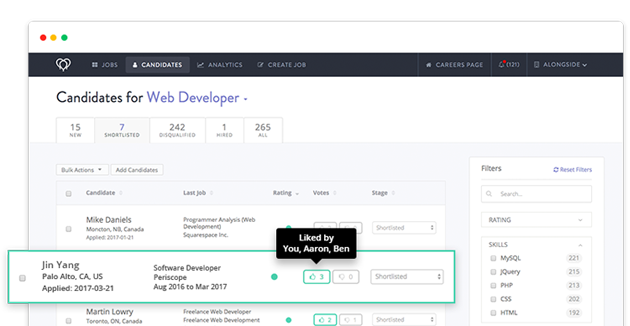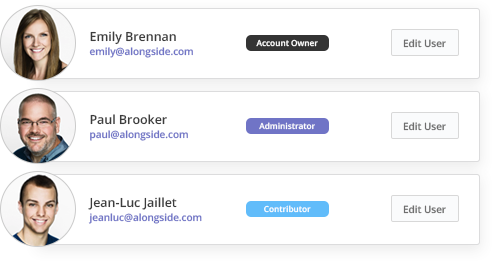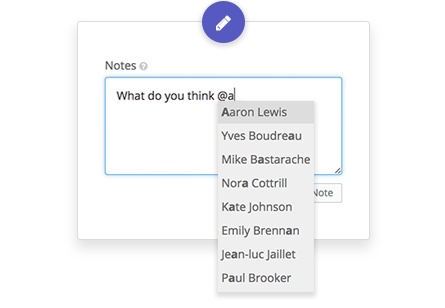Collaborative hiring: How to improve teamwork and communication
Here’s how collaborative hiring can help you make better decisions and why an ATS is key to efficient communication across your hiring team.
What is collaborative hiring?
Collaborative hiring is an approach to recruitment and selection where employees from various aspects of the business (and sometimes recruiters) participate and give input. It’s often also referred to as ‘team-based hiring’. Multiple members of the team may take part in job promotion, pre-screening, one-on-one interviews, or group interviews. Decisions may be reached through consensus or simply through taking team members feedback into consideration. Collaborative hiring has been linked to higher employee engagement, lower turnover, and positive impacts to the company’s bottom line.
As well, involving recruiters in this process helps less-experienced team members keep bias in check and tap into role-fit insights they might not have without years of experience.
Read more: All the advice you need to manage your unconscious bias
Why collaborative hiring?
It’s always good to have a second pair of eyes, right? Well, this applies to recruitment as well.
Not only can collaborative hiring help us minimize personal bias, but it usually helps us to make smarter decisions in the selection process. Our team members may notice something or bring up important points that we might never consider ourselves. As well, collaborative hiring typically allows for better insights about culture fit. This practice can also help to bring more diversity to your team.
Who should be involved?
Team members involved in hiring depends on your organization. If you’re a small shop or startup, you might have several of your team members across functions participating in hiring decisions. This situation is typical in small companies where no one is classically trained in HR, and everyone is involved in group decision-making.
In medium to large-sized companies, any combination of owners, managers, and HR professionals make up your core hiring team. In some cases, hiring is the sole responsibility of an HR manager or several members of an HR department. The composition of your hiring team often reflects the corporate structure and level of participation of management in recruitment decisions.

Collaborative hiring encourages employee input into hiring decisions.
Direct management’s feedback is often integral to determining role fit. Managers are often asked to weigh in on applicants or even sit in on interviews. It’s important to coach anyone who isn’t familiar with HR practices about how to keep bias in check, ask appropriate questions, and give tips for identifying culture fit.
Hire Better: Focus on your mission, vision and values
Some organizations also engage internal or external recruiters. These are the folks well-versed in the best practices of hiring. When it comes to guiding your recruitment practices, these recruiters can support from crafting eye-catching job descriptions to making strategic culture fit decisions. They also often have extensive networks so they can recommend top talent.

Employees can participate in the pre-screening process.
Here’s an excellent guide to setting up your collaborative hiring process from Ragini Holloway from her days as VP of Talent Operations at Credit Karma.
How can an ATS help?
A few Applicant Tracking Systems (ATS) come with features that support collaborative hiring, and even encourage it! Adding team members to your account is an efficient way to communicate during the hiring process. Some products even allow for unlimited ‘seat’ access, which is ideal for larger organizations with multiple hiring teams or locations.
Having multiple seats enables your team to pre-screen resumes, rate candidates, and leave notes on candidates, all from the ATS. These features eliminate the annoying process of searching for comments and feedback in your inbox and trying to recall which application they had initially been assigned to. A massive headache removed, especially if you have hundreds of applications to sort through!

Privacy is a concern when it comes to giving team members access to your ATS. Scenarios such as confidential postings and internal applicant privacy concerns are typical in recruitment. Another issue might be wanting to keep credit card information from team members or external recruiters. Choosing an ATS that allows for posting-specific access removes this obstacle.
With Alongside, you can select which job postings you want account users to see, but hide others. You can also email applicants (in a bulk post or individual applications) to people outside of your user base. They can view and give feedback that is stored back into the ATS, without them ever having inside access to your account. As well it’s an excellent way to improve communication between a hired recruiter and your team. They’ll have access to the applicants, and you’ll be able to be notified of their feedback, stored right on your account.

Tag teammates so they see your feedback on applications.
Collaborative hiring is a must, for so many reasons. What you need is a platform that helps you work better as a team. Alongside does just that. Find out more through a free demo!
{{cta(‘9e492057-db39-498c-9a92-228c7ea3ccef’)}}
